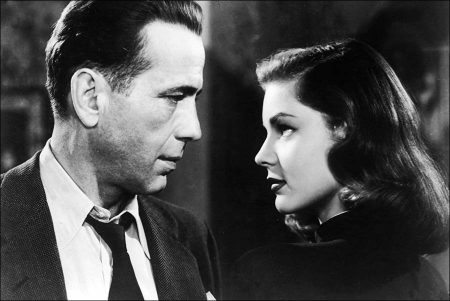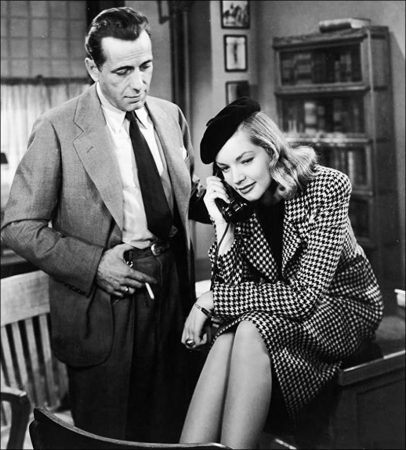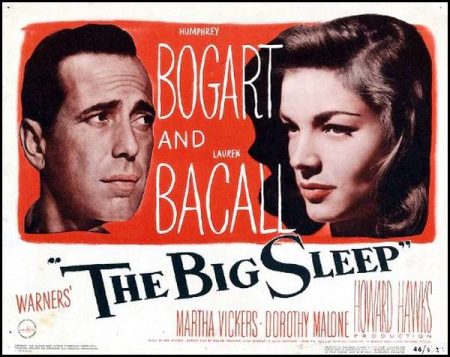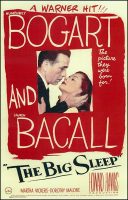The Big Sleep movie storyline. Detective Philip Marie’s hired by an old general to stop a blackmail plot concerning his daughter, Carmen. A series of clues puts Marlowe in touch with several seed people. Soon, Marlowe is involved with another of the general’s daughters; Vivian. This leads to love, a divorced beauty. She and romance and her double-crossing him.m. Everyone, including the DA, warns Marlowe to stop the investigation, but he can’t. Marlowe decides to set up a trap for person who’s responsible for all his troubles.
The Big Sleep is a 1946 film noir directed by Howard Hawks, the first film version of the 1939 novel of the same name by Raymond Chandler. The film stars Humphrey Bogart as private detective Philip Marlowe and Lauren Bacall as Vivian Rutledge in a story about the “process of a criminal investigation, not its results”. William Faulkner, Leigh Brackett and Jules Furthman co-wrote the screenplay. In 1997, the U.S. Library of Congress deemed the film “culturally, historically, or aesthetically significant,” and added it to the National Film Registry.
Parts of the unreleased 1945 cut were significantly re-scripted and shot to take advantage of the public’s fascination with “Bogie and Bacall”. The original 1945 version was restored and released in 1997.
About the Production
The composition of the screenplay involved three writers, including the American novelist William Faulkner. The writing was influenced by a primary focus of the Hays Office censorship policies which were often used to heavily restrict sexual themes. In the novel, Geiger is selling pornography, illegal then and associated with organized crime, and is a homosexual having a relationship with Lundgren. Likewise, Carmen is described as being nude in Geiger’s house, and later nude and in Marlowe’s bed.
To ensure the film would meet the production code and gain the approval of the Hays Office, changes were made. Carmen had to be fully dressed, and the pornographic elements could only be alluded to with cryptic references to photographs of Carmen wearing a “Chinese dress” and sitting in a “Chinese chair”. The sexual orientation of Geiger and Lundgren goes unmentioned in the film because explicit references to homosexuality were prohibited. The scene of Carmen in Marlowe’s bed was replaced with a scene in which she appears, fully dressed, sitting in Marlowe’s apartment, when he promptly kicks her out. The scene, shot in 1944, was entirely omitted in the 1945 cut but restored for the 1946 version.
The Big Sleep is known for its convoluted plot. During filming, neither the director nor the cast knew whether the chauffeur Owen Taylor had killed himself or was murdered. A cable was sent to Chandler, who told his friend Jamie Hamilton in a March 21, 1949 letter: “They sent me a wire … asking me, and dammit I didn’t know either”.
After its completion, Warner Bros. did not release The Big Sleep until they had turned out a backlog of war-related films. Because the war was ending, the studio feared the public might lose interest in the films, while The Big Sleep’s subject was not time-sensitive. Indications of the film’s wartime production include period dialogue, pictures of President Franklin D. Roosevelt, and a woman taxi driver, who says to Bogart, “I’m your girl.” Wartime rationing influences the film: dead bodies are called “red points”, which referred to wartime meat rationing, and Marlowe’s car has a “B” gasoline rationing sticker in the lower passenger-side window, indicating he is essential to the war effort and therefore allowed eight gallons of gasoline per week.
The “Bogie and Bacall” phenomenon, a fascination with the couple that began with To Have and Have Not, was well developed by the end of the war. Bacall’s agent, Charles K. Feldman, asked that portions of the film be re-shot to capitalize on their chemistry and counteract the poor reviews Bacall had received for her performance in Confidential Agent (1945) which was released prior to The Big Sleep, even though it was produced after the original principal photography.
Producer Jack L. Warner agreed, and new scenes for The Big Sleep, such as the sexually suggestive racehorse dialogue, were added (scripted by an uncredited Julius Epstein). The re-shot ending featured Peggy Knudsen as Mona Mars because Pat Clark, the originally cast actress, was unavailable. Furthermore, the parts of James Flavin and Thomas E. Jackson were completely eliminated. Because of the two versions created by the re-shooting, there is a substantial difference in content of some twenty minutes between them, although the difference in running time is only two minutes. Novelist Raymond Chandler said Martha Vickers (Carmen) overshadowed Lauren Bacall (Vivian) in their scenes together, which led the producers to delete much of Vickers’ performance to enhance Bacall’s.
All about The Big Sleep (1978)
The Big Sleep (1946)
Directed by: Howard Hawks
Starring: Humphrey Bogart, Lauren Bacall, John Ridgely, Martha Vickers, Dorothy Malone, Peggy Knudsen, Regis Toomey, Charles Waldron, Charles D. Brown, Bob Steele, Elisha Cook, Louis Jean Heydt
Screenplay by: William Faulkner, Leigh Brackett, Jules Furthman
Production Design by: Eric Stacey
Cinematography by: Sidney Hickox
Film Editing by: Christian Nyby
Set Decoration by: Fred M. MacLean
Art Direction by: Carl Jules Weyl, Max Parker
Makeup Department: Perc Westmore
Music by: Max Steiner
MPAA Rating: None.
Distributed by: Warner Bros. Pictures
Release Date: August 23, 1946 (United States)
Visits: 231




